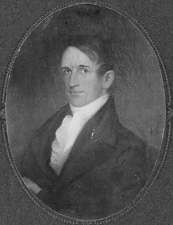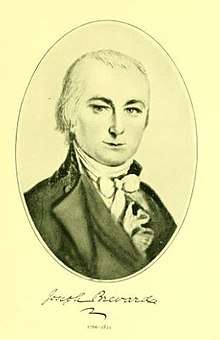South Carolina's 9th congressional district
The 9th congressional district of South Carolina was a congressional district for the United States House of Representatives in South Carolina. It was created in 1813 as a result of the 1810 Census and eliminated in 1843 as a result of the 1840 Census. The district was last represented by Patrick C. Caldwell.
List of members representing the district
| Name | Party | Years | Cong ress |
Electoral history | District location |
|---|---|---|---|---|---|
| District created in 1813 | |||||
| John Kershaw (Camden) |
Democratic-Republican | March 4, 1813 – March 3, 1815 |
13th | Elected in 1812. Lost re-election. |
1813–1823: "Sumter district" |
| William Mayrant ([data unknown/missing]) |
Democratic-Republican | March 4, 1815 – October 21, 1816 |
14th | Elected in 1814. Lost re-election and resigned. | |
| Vacant | October 21, 1816 – January 2, 1817 | ||||
 Stephen Decatur Miller (Sumterville) |
Democratic-Republican | January 2, 1817 – March 3, 1819 |
14th 15th |
Elected in 1816. Elected November 25 & 26, 1816 to finish Mayrant's term and seated January 2, 1817. Retired. | |
 Joseph Brevard (Camden) |
Democratic-Republican | March 4, 1819 – March 3, 1821 |
16th | Elected in 1818. Retired. | |
| James Blair (Lancaster County) |
Democratic-Republican | March 4, 1821 – May 8, 1822 |
17th | John S. Richards was elected in 1820 but declined to serve. Elected February 5 & 6, 1821 to finish Richards's term. Resigned. | |
| Vacant | May 8, 1822 – December 11, 1822 | ||||
| John Carter (Camden) |
Democratic-Republican | December 11, 1822 – March 3, 1823 |
Elected in October 1822 to finish Blair's term and seated December 11, 1822. Redistricted to the 8th district. | ||
| Starling Tucker (Mountain Shoals) |
Democratic-Republican (Jackson) | March 4, 1823 – March 3, 1825 |
18th 19th 20th 21st |
Redistricted from the 5th district and re-elected in 1823. Re-elected in 1824. Re-elected in 1826. Re-elected in 1828. [data unknown/missing] |
1823–1833: "Newberry district" |
| Jacksonian | March 4, 1825 – March 3, 1831 | ||||
| John K. Griffin (Clinton) |
Nullifier | March 4, 1831 – March 3, 1837 |
22nd 23rd 24th 25th 26th |
[data unknown/missing] | |
| 1833–1843: [data unknown/missing] | |||||
| Democratic | March 4, 1837 – March 3, 1841 | ||||
| Patrick C. Caldwell ([data unknown/missing]) |
Democratic | March 4, 1841 – March 3, 1843 |
27th | [data unknown/missing] | |
| District eliminated in 1843 | |||||
gollark: Your solution shouldn't overly rely on a central authority, be reasonably adaptable and quick with changing circumstances, and actually make the incentives work.
gollark: > sure resource distribution is nontrivial but its not that hardWhat do you propose to do for it?
gollark: Hack into Twitter again and make Trump tweet about the asymmetrical emoji.
gollark: Mail slightly asymmetrical foxes to the twemoji people in real life.
gollark: Highlight all the asymmetry.
References
- Martis, Kenneth C. (1989). The Historical Atlas of Political Parties in the United States Congress. New York: Macmillan Publishing Company.
- Martis, Kenneth C. (1982). The Historical Atlas of United States Congressional Districts. New York: Macmillan Publishing Company.
- Congressional Biographical Directory of the United States 1774–present
This article is issued from Wikipedia. The text is licensed under Creative Commons - Attribution - Sharealike. Additional terms may apply for the media files.